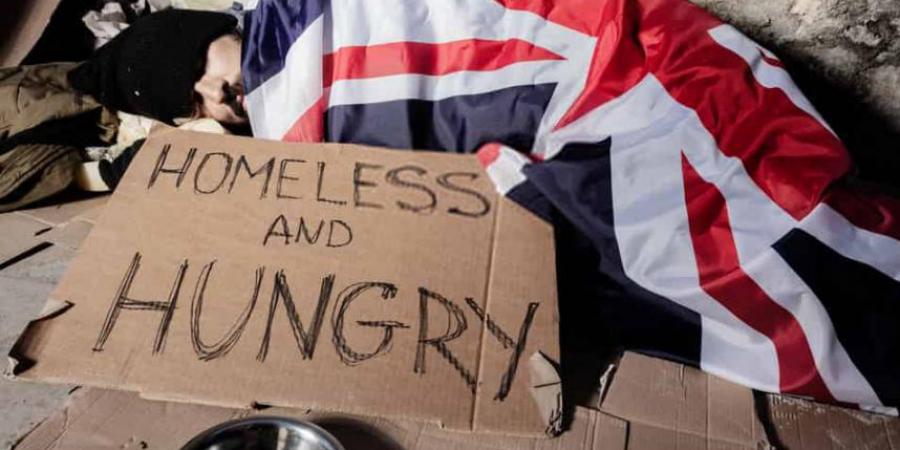How Many Homeless People are there In UK

03 Dec 2019
Introduction: - In London, 170K people are without a home, and in the country, the figure reached 320K where 295K live in temporary accommodation. Analysts at housing charity Shelter found that growing rents and lack of social housing led to record growth in the number of people sleeping out on the streets and those living in overcrowded single rooms.
The rate of such people is growing at 4% per annum. The number continues to grow even in rural England as Sky News claimed the rate of rough sleepers increased by 33%.
Reason behind Homelessness
New developments made housing unaffordable for the low-income group.
The scenario of homelessness in the UK
From the last few Shelter surveys, it became possible to measure the approximate number of homeless people in England, and it found more or less 3.2M (3,25,000) people stay in the UK without shelter.
Number of Homeless People
Almost 4266 people live on the streets of England. The number depends on a single night's report and the local administrations' estimations.
Homeless People in England and Scotland
In December 2019, the survey on rough sleepers found that nearly 280,000 people have no home in England. The agencies collected comparable data from Wales and Scotland.
The agencies measured the homelessness data by estimating the number of households who contacted the administration for support. In 2019-20, about 288,470 families got subsidies from the government of England and got relief.
But in Wales, only 9,993 households got support. Scotland's chief statistician revealed that between April 2019 to September 18,465 petitions were submitted to parliaments for support. The statistics related to homelessness were estimated from the data collected in the surveys.
The last survey(in 2019-20) reported by the Scottish government found that nearly 2890 people were rough sleepers, while the numbers of homeless estimated from surveys found that 62 per cent of people didn't apply for help.
HOMELESSNESS IN THE UK FACTS
The number of newly built homes is increasing yearly, but the number of homeless people has not declined. It is because so many people suffer from homelessness problems in the UK, and the number of homelessness in children is getting higher every year. People living on the streets, and rough sleepers, are also increasing.
HOMELESSNESS FACTS
Due to the problem of homelessness in society, several other problems are arising. For example, people suffer from losing a permanent dwelling and health problems.
Outcomes of Homelessness
-
In Britain, rent continues to increase in the capital city, which is beyond the reach of the average salaried worker.
-
It is reported that almost one in six prisoners become homeless while staying in custody.
-
Homeless people living on the streets are more prone to suicide than people living in their own houses.
-
The average life age of the people is between 76 to 81, but due to homelessness, the average age declines to 42 to 44.
-
One hundred fifty thousand young people all over the UK ask for support yearly against home loss.
-
Many people are dying from the homeless problem, as they have an insecure life. About 600 people died in England and Wales due to it.
-
Approximately 8,900 people sleep in the UK - in cars, public transport, tents, vans, and streets.
Facts about Homelessness in the UK 2019
During 2019-20, state communities offered 288,470 inhabitants help to prevent homelessness. Since 2018, recoveries have increased by 14.9%.
The majority of families with children seek help, while other individual residents qualify for help during relief times when they are genuinely homeless.
Acceptance of an application for homelessness relief declined by 29.3%, from 56,600 before HRA during 2017-2018 to 40,040 throughout 2019-20. Other figures of race, maturity level, and structure overview of the households are subsequently measured before the management makes any such approvals.
In 2018, the Poverty Mitigation Legislation was introduced, with some new protocols and guidelines. An initial study of something like the change of residents entitled to living on the streets across the fiscal period 2018-19 was conducted.
After December 2018, the surveys also unleashed the annual reports on legally recognised rough sleepers. Statistics for January to March 2020 are presented in perhaps the most recent issue reporting on 20 August 2020. For the complete analysis of the collected data across the term, such a yearly report considers initially disclosed statistics that find -
-
Almost 1 in 6 individual inmates say that they might be homeless after detention.
-
Though it seems 170,000 residents face the worst kind of deprivation, the number is expected to grow in the next 25 years and is projected to more than double unless an improvement is made.
-
A rough sleeper on the streets seems substantially more prone to attempt suicide.
-
Since 2010, rough sleepers rates have grown by 165%.
-
The number grows by 150,000, and many teenagers in the United Kingdom each year seek poverty-related assistance.
-
Ninety-two per cent of British rented accommodation is still unavailable to single individuals, partners, and families with kids who offer federal funding.
-
Throughout England & Wales, approximately 600 persons died in 2017 whilst impoverished.
-
It is reported that 8,900 countrymen sleep in tent camps, vehicles, and public transit elsewhere in the United Kingdom.
Child Homelessness Statistics UK 2019
As shown in a survey published recently by the Rescue centre, the data has been collected in twelve years, and it is found that a shocking 135,000 young British citizens are homeless and reside in temporary housing.
Initially, the charitable organisation demonstrated the intensity of children's homelessness by stating that in the country, a child loses home every 8 minutes ( Homelessness survey for the decade). It means 183 children lose home each day.
The study highlights that 5,683 displaced families with young children still live in temporary beds and meals or dormitories, commonly regarded as the worst shelter.
Households are sometimes suffocated under one closet with no place to prepare meals, play, feed, or interact with outsiders. Sometimes, even the housing remains a few kilometres away from the schools, offices, friends and families.
-
Apart from the funds, Luton (1 among every 22 students), Brighton&Hove (1 across every 30, and Manchester) seem to be the areas with the greatest number of abandoned people can be found.
-
In every Britain class, there are an extra five homeless kids per institution in the nation.
-
Throughout Great Britain, Britain's Kensington and even Chelsea, Haringey, Westminster, or Newham townships represent the largest percentage of homeless youth, in which one in twelve children seems to be destitute.
Why are People Homeless?
The way we, as humans, manage existential activities can vary from person to person, especially when there is a state of mental transition. There can be motives for homelessness, drug abuse, and other problems. Substance abuse seems unique to everyone, and it may be caused by pills, alcohol, or a quarrel.
Each scenario is complex and can relate to non-public and environmental reasons.
Homeless teenagers often avoid authorities and may add parents or those around them to foster care. Teenagers who need help within the shelter may be facing personal issues. It may be someone who lives in transitional housing because their home is unstable or non-transitive.
Fifty per cent of adolescents drop out of the care and juvenile justice systems with age and become homeless within six months.
Someone struggling with life and needing tenancy balance assistance may rely on the supported logging system. However, for some, it may be difficult to sustain due to joblessness or other personal factors, so one may live in such homes for a short time before moving to a better place.
What percentage of the UK is Homeless?
The social survey organisations' database searched the percentage of UK residents in the military who are not homeless. London is visited by people from many parts of Britain, Europe and beyond, as it has been supporting immigrants for hundreds of years.
For this, the authorities are not changing the figures of the homeless because it is entirely based on historical data that has now transformed. As a result, many are "hidden homeless" with permanent households, although they no longer meet the statutory definition.
The UK authorities aim to investigate the accuracy of government data. However, even if it is about a smaller percentage of people, it requires upgrading to the latest data.
Many homeless people cite mental health issues, which are one of the reasons for homelessness - 26% of people in the UK are homeless for the same reason.
It suggests that there may be widespread links between homelessness and mental fitness issues; however, this link is often ignored. Those identified as homeless through their neighbourhood authorities are kept in temporary housing.
It is expected that the number of homeless people in England will increase by 30 per cent by 2024 amidst benefit freezes, increasing food prices and rising energy bills as the eviction ban ends in the post covid phase.
More than 66,000 additional people will become homeless by 2024 and be forced to sofa surf as per the housing charity Crisis and Heriot-Watt University predictions.
It is expected that over 8K more will be rough sleeping, and over 9K will have to opt for temporary accommodations. It is expected that the highest surge of the homeless number will happen in councils in London due to an increase in living costs.
How many Homeless people were in the UK in 2020?
In 2020, more than 274,000 people were homeless, and the data from leading organisations found that one in every 206 lived without a stable home. However, the figures could be higher as many are hidden or temporarily dwellers.
In London, one in 53 remained without a home, and Bedfordshire had the second highest rate. The number of people living on the streets has been increasing, and as per the data, in Autumn 2020, 2688 people were sleeping rough, where only 14 % were women, so over 80% of the rough sleepers are men.
Out of the total deaths registered of the homeless, only 12 per cent were women. The study found that women are more likely to find a hidden place to sleep due to the fear of harassment, and it is expected that the statistics missed them because the officials could not spot them.
The average age of such people was between 26 to 65, and the top reason for being without a home is unexpected life changes. Over recent years, evictions from privately rented homes have been increasing.
People suffer unfair evictions due to short contracts and sale of properties, and growing rents. Some suffer due to unexpected life events where they are asked to leave the stable home due to domestic abuse, relationship issues, death of a family member, loss of job or substance abuse.
No two situations can be compared in such a case, as someone can lose their home too quickly. After the evictions, homeless individuals need tailored support from the authorities to meet their needs.
The surveys also found that in 2020 an estimated 688 homeless individuals died in England and Wales, and the average life expectancy of those who suffered homelessness was 45.9 for males and 41.6 for females.
In addition, the data indicates that individuals' age declines when forced to live on the streets as rough sleeping can be dangerous and detrimental to health.
Those who live on the streets suffer health problems due to cold conditions, poor hygiene, disrupted sleep, and little food. The illness often remains untreated, mainly due to inaccessible healthcare.
Almost 30 per cent of individuals die on the streets due to a lack of proper care and treatment. Furthermore, in 2020, 74 rough sleepers committed suicide as such a situation leads to mental issues, anxiety and other problems.
The UK government offered an additional £ 3.2 billion to homeless people. Many youngsters of all economic backgrounds risk waking up on Christmas in an extreme climate, and they face the risk of homelessness due to unaffordability.
Officials in the UK have designed a package of several criteria to help such men and women. However, those living in temporary accommodations and lodges continue to multiply each year.
There are different types of homelessness situations chronic, episodic, transitional and hidden. Those without a permanent home for more than a year are categorised as chronic, whereas those struggling with such conditions may suffer from disabilities, illnesses or addictions.
They may be very old to fight their way out of it. Episodic homeless is a condition which can become chronic when the person fails to get accommodation in a year. Some people face major transformation and difficulties after a catastrophic event and may face it for some time, like suddenly losing a job and remaining homeless until they get a new job.
Hidden jobless is the situation which remains unreported where someone may be couch surfing and may get a permanent house in some days or months. It represents they depend on family or friends to get a place to live.
How many Homeless Shelters are there in the UK?
Some social organisations partner with other groups to help volunteers secure significant finance for building and renovating homes within the UK. Those findings suggest engaging with intellectual teams to develop strategic objectives for homeless shelters.
The aim of such an association should be to work to provide safe and dynamic space areas for prone and disabled youth. In addition, the range of leaving earning members or handing over to dependents has grown recently, so they need to provide tailored support.
Yet, some social organisations are working to promote human rights and bring justice to the people collectively, providing justice with the help of the supply of legal resources.
Conclusion: -
Homelessness impacts many, and the report on such individuals involves those living on the streets and even those forced to live in temporary homes. Government reports on homeless individuals aim to get information to get a UK-wide picture of the issue and have a comparative discussion to find a solution to the problem.
Government agencies are trying to determine how many people have been homeless to identify the need for support, compare the data, and get the number of people living in hidden locations.
- Euston Road, Bangor
- Natex, Liverpool
- Why is homelessness an important issue
- What is supported housing
- What is a cash buyer
- What happens when a housing bubble bursts
- What does SSTC Mean
- How To Find Out Who Owns A Property By Address For Free UK
- How To Buy Property with No Money UK
- How to avoid stamp duty on house purchase
- How To Avoid Inheritance Tax On Property
- How to attract investors in a business plan
- How much notice does a landlord have to give
- How Much Housing Benefit Can I Get
- How Much Do Real Estate Agents Make UK
- How Much Do Estate Agents Earn
- How much can I borrow on a let to buy mortgage
- How Many Homeless People are there In UK
- How Long To Keep Mortgage Statements
- How Long Does Stamp Duty Refund Take
- How Do Police Find Grow Houses UK
- What Does Leasehold Mean When Buying A House









